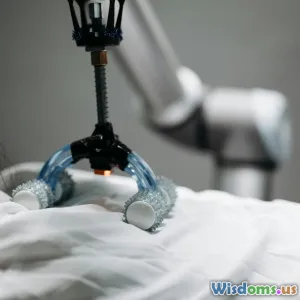
The Impact of Robotics on Waste Disposal
7 min read Explore how robotics is transforming waste disposal, enhancing sustainability and environmental conservation in innovative ways. (0 Reviews)
The Impact of Robotics on Waste Disposal
In an era where sustainability is more critical than ever, the integration of robotics into waste disposal systems emerges as a sustainable solution to some of our most pressing environmental challenges. The advent of robotics technology is reshaping the waste management industry, enhancing efficiency, reducing costs, and most importantly, supporting efforts towards a cleaner environment. This article delves into the advantages of robotics in waste disposal, examines real-world applications, and underscores the potential for a greener future.
The Need for Innovative Waste Management Solutions
A Growing Problem
According to the World Bank, global waste is projected to increase from 2.01 billion tonnes in 2016 to 3.40 billion tonnes by 2050 if no actions are taken. This significant increase is driven by urbanization, population growth, and higher consumption rates. Amidst this growing waste crisis, traditional waste management methods are increasingly becoming inadequate. Waste overflowing in landfills significantly contributes to greenhouse gas emissions, deforestation, and environmental degradation.
Effects on Sustainability
The improper management of waste results in significant environmental impacts, yet ineffective solutions often stem from human limitations. As resources are strained, it becomes crucial to explore innovative approaches, like robotics, to address these environmental challenges effectively and sustainably.
Robotics in Waste Disposal: An Overview
The Role of Robotics Technology
Robotics technology plays a vital role in waste disposal by automating the collection, sorting, and recycling processes. These robotic systems are not only designed for efficiency but also to mitigate human error and enhance safety by managing hazardous waste without endangering workers’ health.
Automation and Efficiency
Many waste disposal companies are now employing robotic systems to streamline operations. For example, AMP Robotics leverages artificial intelligence to improve waste sorting processes. The AMP Cortex robotic system can identify and segregate recyclable materials from general waste streams. According to the company, their technology improves sorting rates by over 80%, demonstrating substantial efficiency in resource recovery and reduction of landfill waste.
Real-World Applications of Robotics in Waste Management
Smart Waste Collection
Robots are being utilized in waste collection as well, with the implementation of autonomous waste collection vehicles like those from the Dutch company, Milgro. These vehicles use GPS and AI to optimize collection routes, reducing fuel consumption and emissions. This not only increases operational efficiency but also significantly reduces the carbon footprint traditionally associated with waste collection.
Waste Sorting Facilities
Advanced robotics have found their way into waste sorting facilities. For example, in Mountain View, California, the start-up Zen Robotics is employing AI-powered robots to improve the recovery rate of recyclables. These robots can identify different types of plastic and paper faster than human workers, vastly increasing the speed of the recycling process while also ensuring more materials are reclaimed. In a country where only 35% of waste is recycled, enhancing recovery rates is essential for sustainable practices.
E-Waste Management
Electronic waste (e-waste) disposal is a burgeoning issue as global consumers replace older devices more frequently. Companies like ERI are implementing robotic solutions to recover precious metals like gold and silver from old gadgets effectively. By using automated systems, ERI increases the efficiency of dismantling electronic devices, normally a labor-intensive process, thereby minimizing electronic waste yields while also recovering valuable materials.
Challenges and Future Outlook for Robotics in Waste Disposal
Capital Investment
Despite the many advantages of incorporating robotics into waste disposal systems, challenges remain. One of the critical barriers to widespread adoption is the capital investment required to install such technology. Smaller waste management companies may struggle to afford this transition, with many opting to maintain legacy equipment rather than upgrading to cutting-edge robotic systems.
Workforce Concerns
Another concern revolves around the workforce. With automation comes the fear of job displacement among waste management workers. While robotics do change the nature of jobs in this sector, it's crucial to note that robots are not made to replace humans but to carry out tasks that heighten the safety and efficiency of human operatives by minimizing risks associated with certain manual jobs.
Evolving Technologies
As robotics technology continues to advance, the capabilities of machines increase, allowing further improvements in waste disposal efficiency. Technologies like AI, machine learning, and computer vision will enable robots to handle a broader range of waste types and identify materials more precisely.
Conclusion: A Sustainable Future with Robotics
The impact of robotics on waste disposal systems is profound, providing critical advancements that align with sustainability goals. As we face significant global waste challenges, investing in robotic solutions can lead to operational efficiencies and improved recycling rates. Effective waste management through robotics presents an opportunity not just to tackle waste but also to pave the way toward a future where sustainability is prioritized, resources are conserved, and our environment is protected. As robotics continue to progress, they represent a significant component in the quest for ecological balance, highlighting the need to adapt and innovate in the face of increasing environmental pressures.
In transforming waste disposal from a purely human endeavor into a collaborative approach involving advanced technologies, we can not only streamline operations, but also honor our commitment to future generations for a cleaner, greener planet.
Rate the Post
User Reviews
Popular Posts




















